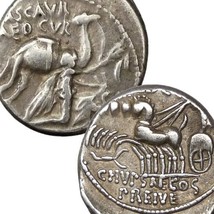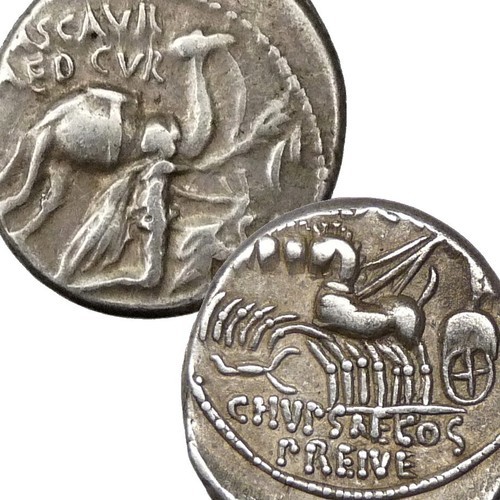age of Pompey, JULIUS CAESAR Coin. Camel, and 50 similar items
Envío gratis
age of Pompey, JULIUS CAESAR Coin. Camel, King Aretas/4 Horse Chariot, Scorpian
View full item details »
Las opciones de envío
Los buques de 1 business day Detalles
No hay precio de envío se especifica en ES
Los buques de
United States

Política de oferta
OBO - El vendedor acepta ofertas en este artículo.
Detalles
La política de devoluciones
Full refund available within 30 days
Protección de compra
Opciones de pago
PayPal accepted
PayPal Credit accepted
Venmo accepted
PayPal, MasterCard, Visa, Discover, and American Express accepted
Maestro accepted
Amazon Pay accepted
Nuvei accepted
View full item details »
Las opciones de envío
Los buques de 1 business day Detalles
No hay precio de envío se especifica en ES
Los buques de
United States

Política de oferta
OBO - El vendedor acepta ofertas en este artículo.
Detalles
La política de devoluciones
Full refund available within 30 days
Protección de compra
Opciones de pago
PayPal accepted
PayPal Credit accepted
Venmo accepted
PayPal, MasterCard, Visa, Discover, and American Express accepted
Maestro accepted
Amazon Pay accepted
Nuvei accepted
Rasgos del artículo
| Categoría: | |
|---|---|
| cantidad disponible: |
Sólo uno en stock, para muy pronto |
| Condition: |
Unspecified by seller, may be new. |
| Date: |
58 BC |
| Composition: |
Silver |
| Denomination: |
Denarius |
| Historical Period: |
Roman: Republic (300 BC-27 BC) |
| Year: |
58 BC |
| Era: |
Ancient |
| Grade: |
Choice VF |
Detalles del anuncio
| Las políticas del vendedor: | |
|---|---|
| Envío de descuento: |
Vendedor paga el envío para este artículo. |
| Publicado en venta: |
May 19 |
| Artículo número: |
1747665877 |
Descripción del Artículo
Right Click picture and select "view/open image..." to see large hi-resolution image.
ROMAN REPUBLIC
ANCIENT COINAGE
M. Aemilius Scaurus and Pub. Plautius Hypsaeus
58 BC
Time of The First Triumvirate ~ Julius Caesar, Pompey the Great, and Marcus Licinius Crassus
First Trimvirate 59-53 BC.
Rome Mint. Struck 58 BC, Silver Denarius. 18mm. 3.83g.
Obverse: Nabatean King Aretas (Aristobulus II, High Priest and King of Judaea then held captive in Rome by Pompey the Great) kneeling right, holding reins in left hand and
olive branch tied with fillet in extended right hand before camel
standing right; M ? SCAVR/AED CVR above; EX S C across field; REX
ARETAS in exergue.
Reverse: Jupiter driving galloping quadriga (four horse Chariot) left, holding reins in left hand and
hurling thunderbolt with right; horses trampling Scorpian; P HVPSAE/AED CVR in two lines above;
CAPTV upwards to right; C HVPSAE COS/PREIVE in two lines in exergue..
This obverse type represents the submission of Aristobulus II to Pompey; Aristobulus II attempted to
usurp the throne of Judea from his brother John Hyrcanus II between 67
and 63 BC. Pompey the Great sided with Hyrcanus and subjected Jerusalem
to a brutal siege and sacking to depose the usurper Aristobulus. Forced
to kneel in submission to Pompey, Aristobulus was permitted to live as a
hostage in Rome, but later escaped and tried to resume the throne, only
to be thwarted again by Pompey's lieutenant M. Aemilius Scaurus.
The
precise date of the curule aedileship of Scaurus and Hypsaeus has been
recorded, providing a valuable fixed point of chronology of the later
Republican coinage. The remarkable obverse type commemorates the
surrender in 62 BC of Aretas III, king of the Nabataean Arabs, to
Scaurus himself, the first instance of a moneyer publicising an event
from his own career on the coinage. The reverse follows the Republican moneyer tradition by commemorating a past deed of the moneyer's ancestor, recalling that it was his ancestor, the consul Gaius Hypsaeus, who captured the Volscian town of Privernum.
Aemilius Scaurus, in 62 B.C.,
as questor to Pompey, was sent against King Aretas but withdrew when
Aretas paid 300 talents. Aemilius was curule aedile when this coin was
struck. Later he was praetor and propraetor, lost a campaign for Consul,
and successfully defended Cicero. In 52 B.C., he was charged with
bribery and went into exile. Marcus Aemilius Scaurus was a Roman
politician of the 1st century BC and son of Marcus Aemilius Scaurus and
Caecilia Metella Dalmatica. Scaurus lost his father when he was very
young, but his education was ensured by several other family friends.
Pompey the Great was briefly married to his sister Aemilia Scaura and,
even after her death, Pompey continued to take personal interest in the
young man.
During the Third Mithridatic War, Pompey asked for
Scaurus by name to become his military tribune, and charged Scaurus, at
the time quaestor, with the responsibility for the Judea region, which
was involved in a bloody civil war between the brothers Hyrcanus and
Aristobulus. Caught in a siege by the Nabatean king Aretas III,
Aristobulus asked for Pompey's intervention through Scaurus, and offered
an enormous bribe. After Scaurus convinced Aretas to end the siege (64
BC), Aristobulus accused Scaurus of the extortion of 1000 talents, but
Pompey, who trusted his brother-in-law, decided to give Judea to his
opponent Hyrcanus (63 BC).
In 62 BC, when Pompey returned to
Rome, Scaurus moved war to Petra, capital of the Nabatean Kingdom, but
relieved the siege after receiving a bribe of 300 talents. In 58 BC, as
aedile, Scaurus organized the Aedilician Games, long remembered for
their extravagance.
Praetor (56 BC) and propraetor (55 BC) in Sardinia, Scaurus was
supported by the First Triumvirate for the consulship in 54 BC, but was
accused of extortion in his province. Scaurus was defended by Cicero,
and acquitted in spite of his obvious guilt. In 53 BC, however, he was
accused of ambitio (shameless bribery) and went into exile.
He married Mucia Tertia, who had previously been married to Pompey the
Great. With Mucia, he had a son also named Marcus Aemilius Scaurus,
consequently the half-brother of Sextus Pompey (son of Pompey the Great
and Mucia).
Scaurus' massacres are mentioned in the Dead Sea scrolls. He was said
by Pliny the Elder to have been the first Roman collector, or major
collector, of engraved gems (Natural History, Book 37, Chapter 5).
Ref. Plautia 8; Aemilia 8; Crawford 422/1b; RBW 1519; Syd. 913. Good Very Fine.
~~~~~~~~~~~~~~~~
OUR GUARANTEE: All illustrations are of the actual item offered. The authenticity of all pieces is fully guaranteed. Any item ever shown otherwise may be returned unaltered for full refund less shipping.
Additionally, if any item purchased is not to your satisfaction you may return it unaltered within 30 days of purchase for a full refund less shipping. We also guarantee absolute discretion and confidentiality in all transactions.
All images, description Copyright 2017 ZEUS GALLERY ID zeus_gallery and may not be used without permission.
|
Why are we showing these items?
Search Results
Coin, coins: ancient"coin" Category "Coins: Ancient"
|

-
Refine your browsing experience
We can show you more items that are exactly like the original item, or we can show you items that are similar in spirit. By default we show you a mix.
Este artículo ha sido añadido a su carrito
 age of Pompey, JULIUS CAESAR Coin. Camel, King Aretas/4 Horse Chariot, Scorpian added to cart.
Único disponible en stock
age of Pompey, JULIUS CAESAR Coin. Camel, King Aretas/4 Horse Chariot, Scorpian added to cart.
Único disponible en stock
Ver el carro o seguir comprando.
 Por favor, espere mientras termine de agregar este artículo a su carrito.
Por favor, espere mientras termine de agregar este artículo a su carrito.
Get an item reminder
We'll email you a link to your item now and follow up with a single reminder (if you'd like one). That's it! No spam, no hassle.
Already have an account?
Log in and add this item to your wish list.




































